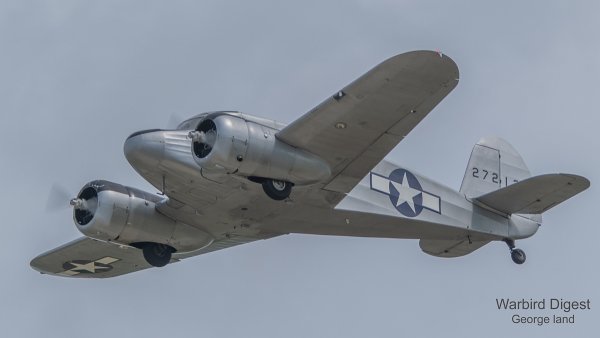-
Posts
5,297 -
Joined
-
Last visited
-
Days Won
78
Content Type
Profiles
Forums
Gallery
Downloads
Blogs
Events
Store
Aircraft
Resources
Tutorials
Articles
Classifieds
Movies
Books
Community Map
Quizzes
Videos Directory
Everything posted by old man emu
-
Camlocs can be obtained from any of the major aircraft hardware suppliers. Here is the spec sheet for them What could be the reason for this different, longer bolt? More than likely it was used to attached something like a video camera. The bolt itself is probably not long. It is the long nut that is fooling you. Repair ideas for this one? Rivet a doubler sheet? Either buy a new panel or get the drawing and material specs and make a new one. Making a new one is quite OK if you have the data. The job comes under the approvals for MITCOM - Manufacture in the Course of Maintenance. Just make sure that an entry is made in the aircraft's logbook that shows the source of the data and materials. Any concerns for the strut attachment plates? Not if you get a bucket of paintstripper to expose the seams, and have the welds checked for cracking. BRS cover is made of thin plywood. Any recommendations for a more suitable material? Contact the manufacturer of the BRS to find out what material can be used. I think aluminium or plastic would be too stiff and would prevent the BRS from exiting the fuselage if required. Rubber grommets You're a wealthy aircraft owner. Splurge a few Euro on new grommets.
-
Australians aren't mugs when it comes to designing tomorrow's aircraft today. In the twenty-five years between 1930 and 1955 this Nation with a population of only 6.75 million, babes to the graves, developed a number of worthwhile military and civilian aircraft. Total numbers produced were low, mainly because of the economic drivers, supply and demand. Even our wartime production was minimal compared to other nations (Wirraway 755; Boomerang 250), but those low numbers can be explained by the switch to the manufacture of British designs and assembly of US-supplied aircraft. But with the end of WWII, and the discovery that the jet engine could push an aircraft higher and faster, the Commonwealth Aircraft Corporation set about designing one that could meet the unique operational problem besetting Australia: distance. And design they did, creating the CA-23. But enemy gunfire was not what destroyed it. It was kowtowing to the British. The very same British who used Australians to save its neck in Africa and Europe, but couldn't spare aid to help against an Asian aggressor. The CA-23 had the potential to be a world-class first generation jet fighter, but British snobbery and Empire thinking killed it off at the wind tunnel stage. This video tells the the basic story of the CA-23 and the political shenanigans that halted its development.
-
I was rearranging stuff in my storage shed when I came across a portable filing cabinet I bought in he very distant past. When I opened it to see what it contained, I was pleasantly surprised to find some magazines from the 1980s about radio controlled flying as well as sheets of plans for a number of aircraft from the inter-war years. I have plans for: a 48" Ford Flivver by Derek Woodward through the American Radio Control Modeller a 58-1'4" Aeronca C1 by Phillip Kent through the English Radio Control Modeller a 53" CAC Boomerang from Australian Radio Control Modeller a 42" DH89 Dragon Rapide from Dumas Aircraft, Kit # 1815 and a 52" Comper Swift. If I can make them, I'll have a nice little display.
-
Imagine the cost of replacing all those hoses when a BMW Radiator Hose - Upper for a 325i E9X costs $50 Priced Individually (GST included) Connecting the upper radiator to the top fitting on the engine (next to the oil filter housing). Manufactured by original equipment supplier using the BMW Genuine plastic hose connectors. New cars have more pipes than the Sydney Town Hall organ
-
-
-

Weight, lift and what keeps things in the air.
old man emu replied to flying dog's topic in AUS/NZ General Discussion
After all the discussions of this topic, especially Bernoulli -v- Newton, and hundreds of person-hours of research by NASA and others, I think that the conclusion reached is "We don't know how, but wings work. Live with it." -
Forget about the jet, that brickwork is excellent.
-

Circuit Issues at uncontrolled aerodromes
old man emu replied to kgwilson's topic in Aircraft General Discussion
Facthunter, I wish you would use the Quote facility in some of your poasts. Not doing so makes it hard to see what you are referring to. 1313 Mockingbird Lame, Mockingbird Heights. -

Circuit Issues at uncontrolled aerodromes
old man emu replied to kgwilson's topic in Aircraft General Discussion
That's a very fine thing to do, but if you and I are approaching Cowra how do we both know that we are aware of the easy map points that help getting into the circuit? I tried to establish a set of 10 Nm points for approaching Tooraweenah so that people coming from different directions would have some clue as to where another aircraft was. That work was roundly poo-poohed right here. In the end it didn't really matter because hardly anyone asked to be provided with the information pack. In following this discussion, I am forming the opinion that those engaged General/Recreational aviation consider themselves to be a Sovereign Citizen, someone who believes that he or she is above all laws. -

Circuit Issues at uncontrolled aerodromes
old man emu replied to kgwilson's topic in Aircraft General Discussion
That's the requirement to carry a radio. A hand-held costs less than a mobile phone and weighs a fraction of the ones from years gone by. Still, how many aircraft are obviously carrying radios, but not using them? I wondered why the light twin would do that, then I realised that there was probably no wind, so no advantage in taking off into wind. -

Circuit Issues at uncontrolled aerodromes
old man emu replied to kgwilson's topic in Aircraft General Discussion
I've been eavesdropping on this topic since I don't fly, but from what I have been reading, these are the impressions I get: Despite all the advice, operations at uncontrolled aerodromes are out of control. Despite the authorities publishing advice on operating in and around uncontrolled aerodromes, the advice is generally ignored. Although there is supposed to be a maximum speed limit within the circuit area, the wide range of performance of aircraft using an aerodrome makes it impossible to set a speed limit that the majority of aircraft can operate at. For instance if the maximum speed in the circuit was 70 kts, would that produce an orderly flow of traffic? Perhaps a "No overtaking" rule might work. The published circuit diagrams do not specify the lateral outer boundaries of the circuit. The establishment of Lanes of Entry with readily identifiable starting points might solve the problem of locating aircraft approaching the aerodrome. Avoiding landing fees by failing to make calls within the circuit is tantamount to stealing from the general community and our fellow aviators. It costs a motza to maintain an aerodrome to the standard we would all like. These uncontrolled aerodromes form part of the national transport infrastructure. The Federal Government long ago washed its hands of maintaining aerodromes, leaving it up to local councils or Big Business. Local Councils in rural areas bear the brunt of the maintenance costs, which money comes from the ratepayers. It is any wonder that Councils are closing aerodromes and trying to convert the land to produce higher income? Turbo is spot on about the decline in the practice of adequate flight planning. My recent experience in this area has been well documented elsewhere on this forum. One call cite the adage, I'll not copy and paste what Turbo said about planning because he's correct. The job of flying is not done until the aircraft is shut down on the flight line. To my mind, the decline in flight planning ability has been caused by flight planning is no longer being mandatory, as Turbio laments. While it's handy to be able to use software which only requires one to enter the locations of points A and B to enable the software to access stored aircraft performance and current Met data to produce the information to go from A to B, there is still the need to pre-plan what one is going to do at the departure and destination aerodromes by applying one's knowledge that conditions around aerodromes are different from flight to flight. -

Circuit Issues at uncontrolled aerodromes
old man emu replied to kgwilson's topic in Aircraft General Discussion
Operating at uncontrolled aerodromes seems to be a bit like having a railroad crossing on the road between your place and town. You get so used to simply driving across it because you haven't had to stop for a train there for years. Then one day you are travelling at a time you don't normally travel at, or there is an "special" running on the line. Suddenly you are shocked out of your reverie by a big thing blocking the road. At least trains are big and slow and can only be found in a permanent location. -
I've put the idea aside for a while. The impetus for getting back into flying has been removed, but not for health reasons. I was saving up for lessons, but can only put enough away for an hour per month and that's not enough. I don't know if I could get a personal loan to pay for ten or fifteen hours in a block. Then there's the problem of accessing a plane. Actually, I'm thinking more of getting back into radio control flying. I've got lots of open space now to learn to fly in with no neighbours so I could even use my fuel engines (if they still sell fuel for them). I'm going to buy myself a brushless motor and speed controller and make a trainer out of corflute. I have a couple of 1/4 scale kits and planes for a CAC Boomerang and an early Aeronca C3 (?), but those might just be built as display models.
-
Coonabarabran Aero Club has joined up with the local High School to put a smallish flight simulator in to entice the kids onto aviation. THe conversion from "free period" to flight school is low, but one is better than none. A couple of the lads have passed solo at the club.
-
Wasn't that the way some Indian airlines were getting people trained for Second Officer duty? I thought they basically took the recruit "off the street", bunged them in one of those simulators that was specific for the plane the company wanted the "pilot" to work in. The result was a person who actually could operate one particular aircraft, but had no other aeronautical knowledge. Since all the route details would be uploaded by someone in an office, these "pilots' didn't have the background knowledge that was behind all aspects of flight planning. As for aircraft handling, I doubt if the simulation course would include handling a situation like the Gimli Glider incident.
-
Today I was given a spectacular book about the P-51 Mustangs operated by the RAAF and RNZAF. I have never seen a book so full of detail about the actual aircraft themselves. The book does not go into operations and such, its everything you wanted to know about them from their individual construction number to the paint finishes used for internal surfaces. The book has profiles on each aircraft including the ones built by North American Aviation ( A68-500 to A68-813 and A68-1001 in service and their civilian lives and those build by the Commonwealth Aircraft Corporation (A68-1 to A68-200 and their civilian lives). Available from Red Roo Models of Melbourne (www.redroomodels.com) at a mere $138.60. If you are into making scale models, this book is a unique source of material.
-
- 3
-

-

-
Which just goes to show you that the results of these various tests are not good predictors or descriptors of the state of a person's body. Actually, as I think about it, a stress test is a pretty primitive concept, comparing it to how we test aircraft components. If we want to check for metal fatigue in a spar, we can do several types of non-destructive examinations. I wonder why we can't do an ultrasound examination of the heart. Ultrasound examinations for monitoring foetal development can detect minute details of the foetus from very early in the gestation. Surely an ultrasound would pick up blocked arteries. What does a stress test determine anyway? To my way of thinking, it only shows the heart's reaction to rigorous exercise. How many of us are at their peak aerobic capability? How many of us regularly run continuously for 15 minutes. How many of us have knees in such good condition that they can sustain a continuous 15 minute run?
-
Have a look at the grass near where the photographer is standing. Do I detect the indications of a tailwind? Begs the question of why they didn't use the road.
-
Frank Whittle was robbed of financial gain by Rolls Royce and Rover, the big English makers. For once the Yanks didn't steal something. The technology was given to them because at the time England was too busy building its fighter defences based on the Merlin and other existing British engine designs. The Yanks were not in the War at that time, so had the industrial capacity to do the development. General Electric took on the job and from the English data and their development work, they developed their own engine. It wasn't until the fall of Germany that the Yanks got their hands on the ME-262 to see what the Germans had done. At the time that Bell was developing the P-59, supersonic flight wasn't a goal of the aerodynamic development, so the typical subsonic wind tunnel was sufficient. A cruise speed of 325 kts was lower than the P-51, but the cause was that the initial GE engine was under-powered.
-
Actually, one of the reasons that wing tunnels are used is to reduce the research and development costs of a project. Bell got all the way through to producing a flying prototype before it was found not to meet expectations. If the wind tunnel data had been developed, the USA might have been fielding jet fighters by the second half of 1944.
-
This artistic expression has adorned Hickson Road, Dawes Point, Sydney for quite a few years now. I think it i only recently that the original artist's work was critiqued and the rock anthropomorphised.
-
When you look at the numerous aircraft models that Bell built, you get the impression that apart from the Airacobra, Kingcobra, B29 Superfortress, B-47 helicopter, Bell Aircraft was more involved in experimental work up to the passing of its founder Lawrence Bell in 1956. After the company was purchased by Textron in 1960, a subsidiary, Bell Aerospace Textron, concentrated on developing things for NASA. Regarding the P-59, it was plagued by a basic lack of knowledge in the industry of the performance of jet engines which had an effect on the aerodynamics necessary to design the airframe. The airframe design process further suffered because the head of the USAAF, General Henry "Hap" Arnold, had forbidden use of wind tunnels to test and optimize the design, but later relented somewhat, only allowing the group to use the low-speed tunnel at Wright Field, Ohio. Bell engineers could only guess at the performance characteristics.
-
I find it very interesting that my knowledge of local weather gained from living most of my life in Southwest Sydney or the Southern Highlands is near useless now I live further north. Looking at this synoptic chart, I would be expecting strong south-westerly winds here, but it has been calm. You can see from the forecast synoptic charts that the strong High tends to block the Low from coming much further north than the Murray River and the pressure gradient lessens along a diagonal between the mouth of the Murray and the NSW Central Coast. About 30 kms south of Gilgandra is the boundary between the Macquarie River catchment and the Castlereagh River catchment. It seems to mark a rainfall boundary as well. There's a little village close by the boundary where the rainfall is less than surrounding towns and villages. In describing the rainfall totals there, the locals say that when it rained on Noah for forty days and forty nights, they only got forty points.
-
Becaue no one was game enough to fly with him 😄











